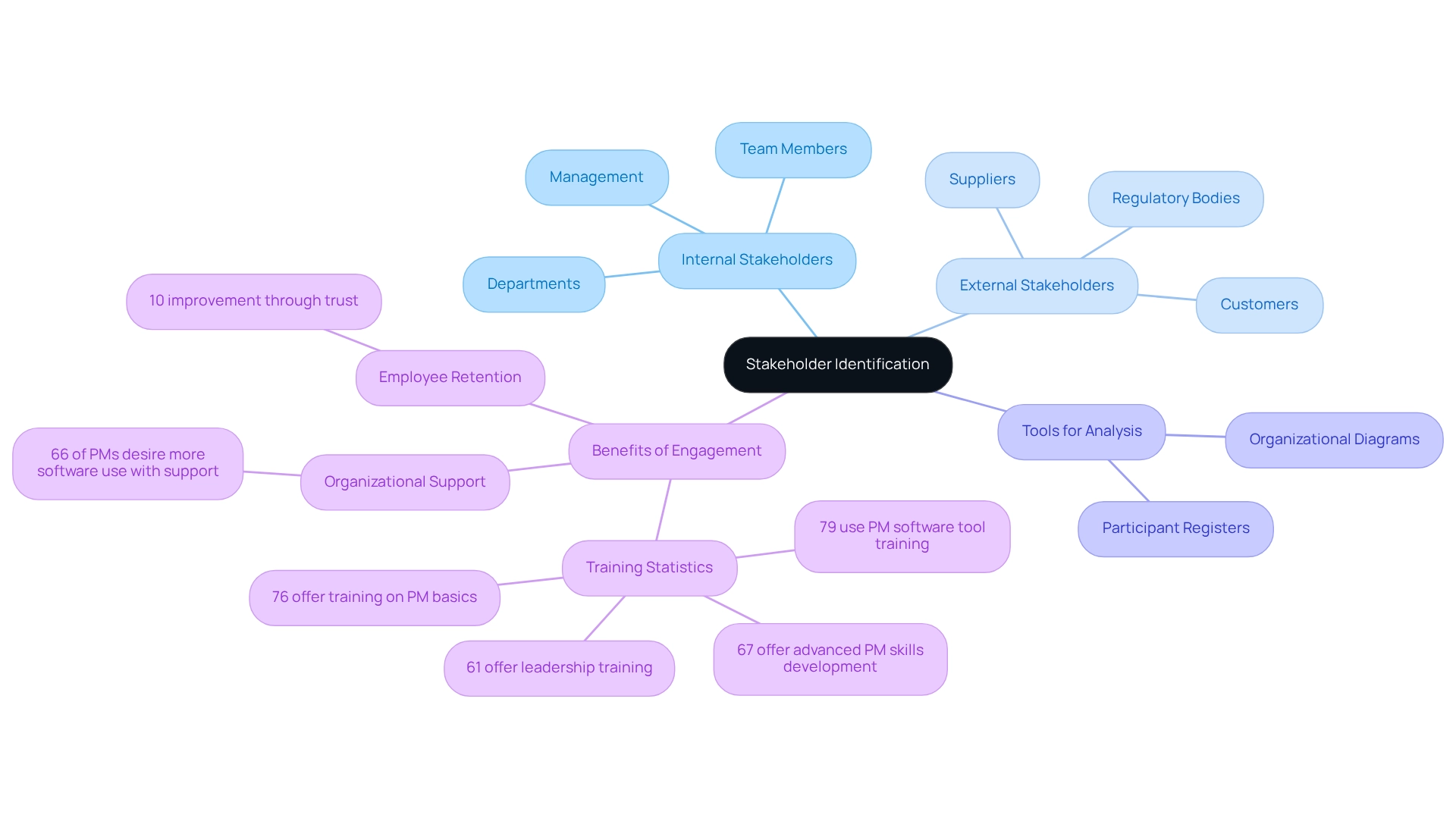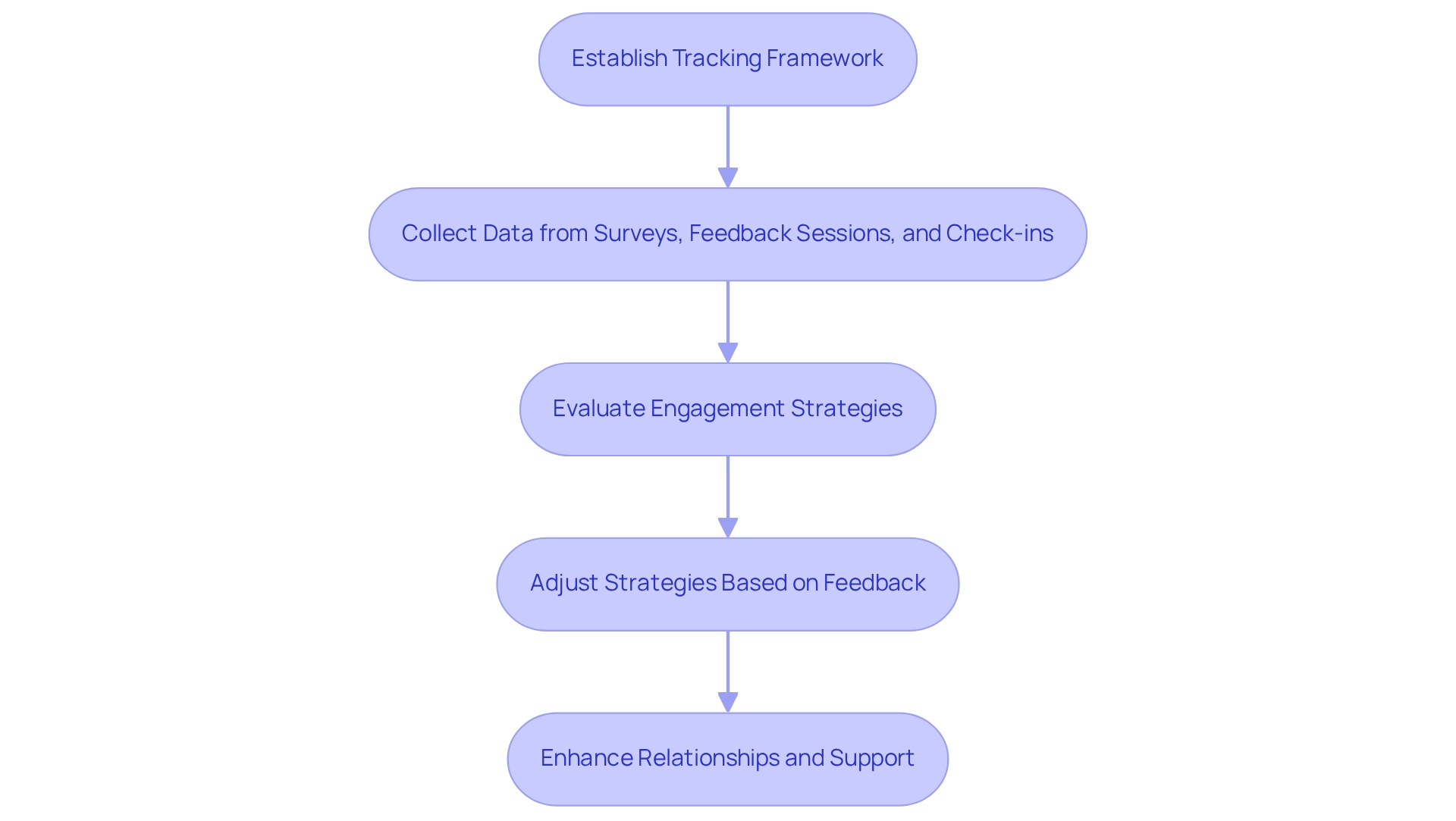Overview
This article delineates a five-step process for conducting stakeholder analysis within project management. It underscores the critical importance of identifying, analyzing, engaging, and adapting strategies for stakeholders, all aimed at enhancing project success. By illustrating how tailored engagement and continuous monitoring of stakeholder interactions can mitigate risks and improve outcomes, the article ultimately advocates for a more effective approach to project management.
Introduction
In the realm of project management, stakeholder analysis stands as a pivotal tool that can dictate the success or failure of initiatives. By systematically identifying and evaluating those who hold a vested interest in a project, organizations can tailor their engagement strategies to foster collaboration and mitigate risks. This article delves into the critical importance of understanding stakeholder dynamics, exploring methods for identifying relevant parties, analyzing their influence and interests, and developing customized engagement strategies. Moreover, insights drawn from recent trends and case studies reveal that prioritizing stakeholder relationships not only enhances project outcomes but also drives sustainable growth in an increasingly competitive landscape.
Define Stakeholder Analysis and Its Importance
An example of stakeholder analysis in project management is a methodical technique for recognizing and assessing individuals or groups that possess a vested interest in or can influence an initiative. This process is essential, as interested parties can significantly sway outcomes, both positively and negatively. By conducting a stakeholder analysis in project management example, managers can recognize the interests, influence, and potential impact of participants, allowing them to tailor involvement strategies effectively and ensure that needs and expectations are met. This proactive engagement fosters cooperation and mitigates risks associated with disconnection or resistance, ultimately enhancing the success rates of initiatives.
Recent trends underscore that optimizing participant involvement can set initiatives on a path to success, with studies revealing that high levels of engagement correlate with increased value and organizational achievement. For instance, a biotech company demonstrated that a high Employee Satisfaction Index (ESI) score was linked to low turnover and high productivity, emphasizing the importance of participant satisfaction in achieving favorable results. Furthermore, expert perspectives indicate that approximately 50% of a company’s worth often derives from merely 15-20 critical positions, underscoring the necessity for focused interest group analysis.
Case studies illustrate that the future of interest group interaction will increasingly prioritize collaboration and innovation. Organizations that refine their interaction practices are likely to witness substantial advancements in outcome results. By prioritizing stakeholder analysis in project management example and implementing proactive engagement strategies, managers can navigate challenges more effectively and drive sustainable growth and success.

Identify All Relevant Stakeholders
To effectively identify all relevant parties, begin with a stakeholder analysis in project management by compiling a comprehensive list of individuals, groups, and organizations that may be impacted by or have an interest in the project. This includes internal parties such as team members, management, and various departments, as well as external entities like customers, suppliers, and regulatory bodies. Utilize tools such as participant registers or organizational diagrams to illustrate connections and ensure that no potential contributors are overlooked. Engaging in discussions with team members can reveal individuals with an interest who might not be immediately visible.
Significantly, studies indicate that 77% of high-performance organizations have formal processes for project management competency development, underscoring the importance of organized participant identification. Furthermore, Gartner's findings reveal that 79% of organizations utilize PM software tool training, highlighting the critical role of training in the efficient management of involved parties. Moreover, establishing trust with these parties can lead to a 10% improvement in employee retention, emphasizing the significance of strong internal relationships. Understanding the interactions between internal and external parties, as illustrated in a stakeholder analysis in project management example, can profoundly influence outcomes, as effective management of these individuals can transform obstacles into opportunities. By prioritizing participant identification and engagement, organizations can enhance project success and foster a collaborative environment.

Analyze Stakeholder Influence and Interest Levels
Recognizing interested parties is just the beginning; a stakeholder analysis in project management example is crucial to classify them based on their impact and engagement levels concerning the initiative. A widely adopted method for this classification is the Power/Interest Grid, which visually represents participants on a matrix that assesses their ability to influence results against their interest in those results.
Stakeholders located in the high power/high interest quadrant necessitate close management and regular communication to ensure their needs are addressed and their support is secured. Conversely, those in the low power/low interest quadrant may require less frequent updates, allowing managers to allocate resources more effectively.
This strategic analysis not only prioritizes engagement efforts but also fosters positive relationships, ultimately reducing risks associated with participant dissatisfaction. Research indicates that organizations employing efficient management strategies for interested parties are significantly more likely—by up to 40%—to complete initiatives on schedule and within budget, as highlighted by expert insights.
Therefore, leveraging the Power/Interest Grid is essential for effective stakeholder analysis in project management example, empowering managers to navigate complex dynamics and enhance outcomes. Furthermore, developing a participant analysis map early in the project can help prevent the oversight of key individuals, while managing unrealistic expectations of involved parties requires a clear definition of project scope and objectives, consistent communication, and active involvement in the decision-making process.

Develop Tailored Engagement Strategies
Understanding the impact and interests of involved parties is crucial for a stakeholder analysis in project management to develop tailored interaction strategies. Each group necessitates a customized approach that considers their preferred communication methods, frequency of updates, and specific information needs.
For influential, highly invested individuals, regular personal meetings can foster deeper involvement and trust. Conversely, lower-priority participants may benefit from periodic newsletters or updates that keep them informed without overwhelming them.
Adaptability is vital; involvement methods should remain flexible in response to participant feedback and evolving circumstances. This proactive approach not only builds trust but also enhances collaboration, which is essential for achieving success in any endeavor.
Given that approximately 50% of project failures stem from inadequate engagement of stakeholders, utilizing a stakeholder analysis in project management can significantly improve outcomes and maintain competitiveness in the market.
To further enhance your engagement with key parties, begin with a comprehensive business assessment to align essential contributors and better understand their needs. As you navigate these challenges, consider 'Talk to Our Experts' for personalized guidance on refining your interaction strategies.

Monitor and Adapt Engagement Strategies
Establishing a robust framework for tracking participant involvement and input is crucial for the initiative's success. Our client dashboard delivers real-time business analytics that facilitate ongoing evaluations of engagement strategies through surveys, feedback sessions, or informal check-ins. This proactive approach allows for the adjustment of strategies based on participant reactions and any shifts in scope or objectives.
Continuous assessment not only addresses potential issues before they escalate but also enhances relationships with stakeholders, as illustrated by a stakeholder analysis in project management example, fostering ongoing support throughout the initiative's lifecycle.
For instance, organizations that measure Engagement ROI have demonstrated improved planning and decision-making, leading to more effective resource allocation and enhanced relationships with stakeholders. Furthermore, a stakeholder analysis in project management example shows that adapting engagement strategies based on stakeholder feedback has proven effective across various projects, ensuring alignment and collaboration.
As emphasized by industry experts, a stakeholder analysis in project management example should be a dynamic process, empowering organizations to effectively visualize and respond to stakeholder needs.

Conclusion
Stakeholder analysis is an indispensable element of effective project management, serving a pivotal role in identifying, engaging, and managing the diverse individuals and groups that influence a project's direction. By systematically recognizing stakeholders and comprehending their interests and levels of influence, organizations can craft tailored engagement strategies that not only foster collaboration but also minimize risks. This proactive approach is not just advantageous; it is essential for driving project success and ensuring sustainable growth in a competitive environment.
The process of stakeholder identification, analysis, and engagement is dynamic and demands continuous attention. Employing tools like the Power/Interest Grid enables project managers to prioritize stakeholders effectively, ensuring that those with the greatest influence receive the necessary attention and communication. This strategic analysis, coupled with customized engagement strategies, cultivates trust and collaboration, significantly enhancing project outcomes. Moreover, organizations that consistently monitor and adapt their engagement efforts based on stakeholder feedback are better positioned to navigate challenges and capitalize on opportunities as they emerge.
In conclusion, the importance of stakeholder analysis cannot be overstated. It is a crucial driver of project success that influences not only immediate outcomes but also long-term organizational value. By prioritizing stakeholder relationships and implementing structured engagement strategies, organizations can elevate their project performance and foster a culture of collaboration and innovation. Embracing this approach will not only yield improved project results but also contribute to sustainable growth and resilience in an ever-evolving business landscape.
Frequently Asked Questions
What is stakeholder analysis in project management?
Stakeholder analysis is a methodical technique for recognizing and assessing individuals or groups that have a vested interest in or can influence a project. It helps managers understand the interests, influence, and potential impact of stakeholders to tailor involvement strategies effectively.
Why is stakeholder analysis important?
Stakeholder analysis is important because interested parties can significantly affect project outcomes, both positively and negatively. By engaging stakeholders proactively, managers can foster cooperation, mitigate risks, and enhance the success rates of initiatives.
How does participant engagement correlate with project success?
Recent trends show that optimizing participant involvement can lead to increased value and organizational success. Studies indicate that high levels of engagement are linked to better results, such as improved employee satisfaction, reduced turnover, and higher productivity.
What are some tools for identifying stakeholders?
Tools for identifying stakeholders include participant registers and organizational diagrams. These tools help illustrate connections among stakeholders and ensure that no potential contributors are overlooked.
What role does training play in stakeholder management?
Training plays a critical role in stakeholder management, as studies indicate that a significant percentage of high-performance organizations have formal processes for project management competency development. Additionally, many organizations utilize PM software tool training to enhance the management of involved parties.
How can establishing trust with stakeholders impact a project?
Establishing trust with stakeholders can lead to a 10% improvement in employee retention, highlighting the importance of strong internal relationships in influencing project outcomes positively.
What future trends are expected in stakeholder interaction?
Future trends in stakeholder interaction will likely prioritize collaboration and innovation. Organizations that refine their engagement practices are expected to see substantial advancements in project outcomes.




